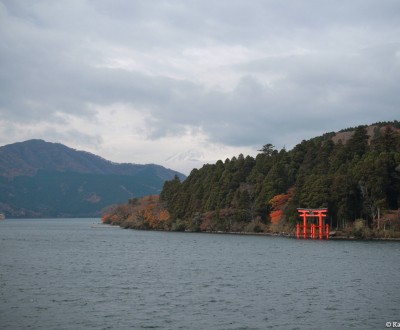Hakone
The Scenic Tour of Lake Ashi
Hakone is a town in Kanagawa prefecture, located 80 kilometers to the south-west of Tokyo. Tourists enjoy this thermal resort hugging the mountainside for its natural hot springs and Lake Ashi from which Mount Fuji is viewable on clear days.
Tokyo’s proximity to Mount Fuji 🗻 is an advantage for those who enjoy viewing the sacred volcano 🌋. Other than Kawaguchiko (Fuji Five Lakes), Hakone is another famous destination of the Fuji-Hakone-Izu National Park.
Hakone Free Pass : the must-have travel pass
Odakyu Railways operates transportation from Tokyo and in Hakone area, so it is best to purchase a Hakone Free Pass which, in the same way as the Japan Rail Pass, includes the unlimited use of several types of transportation in Hakone, the roundtrip from Tokyo as well as discounts in many attractions. The tour of Lake Ashi (Ashinoko) indeed requires the use of several types of conveyance: train, bus, boat, ropeway and cable car 🚙.
The Hakone Free Pass exists in 2 or 3 consecutive days versions. It is indeed possible to spend the night there, for example in a ryokan to enjoy the onsen ♨️ baths. This is what the local tourist office is clearly attempting to sell, in order to boost the local economy. It is however possible to plan many visits and activities on a full day-trip.
The Hakone Free Pass can be purchased in advance. It costs ¥6,100 (~US$41.49) for 2 days or ¥6,500 (~US$44.21) for 3 days.
A comprehensive and well-supervised itinerary
The first step of transportation is a "rapid" train without reservation (not Shinkansen 🚅) which departs every half hour from Shinjuku station. Change at Odawara station, after an hour and a half, for only 15 minutes before arriving at Hakone-Yumoto, the starting point of your trip in Hakone area. There are also direct trains called "Romance Car" with a mandatory reservation, adding a ¥1,200 fee per person per trip.
Once in Yumoto, most of your time is spent in transport between sporadic visits scheduled in the tour.
First, take the bus up the mountain to Moto-Hakone-Ko, a journey which takes 45 minutes with no traffic. Two main attractions have to be visited there (all within walking distance):
- Hakone-jinja, a shinto shrine in the forest, very pleasant to visit with its large torii ⛩️ gate overlooking Ashinoko (a popular picture spot from the lake),
- Cedar Avenue, an ancient road lined by 300 years old Japanese cedar trees, a species which is also found carved in a lot of shops in the area.
Then, aboard the pirate ship at Hakone-Machi-ko dock, to cross the lake in about 40 minutes. The boat can host 500 passengers, and we suggest you directly out onto the deck (and not lay on the seats inside as many tourists do) to enjoy the view of Mount Fuji. If the weather is clear you can take the classic postcard photo of the sacred mountain or Hakone-jinja's floatting torii.
Arriving in Togendaiko station, take the ropeway for 20 minutes. In Owakudani, you can choose to stop and visit the fumaroles of the sulfur quarries or take a second ropeway for about 10 minutes down to Sounzan. There, a 15 minutes’ cable car ride will take you back to Gora. Our advice: get down at the 3rd stop to visit the eponymous park and walk down to Gora.
From there, the Hakone Tozan train will take you through 45 minutes into the mountains back to the starting point, Hakone-Yumoto. Then you can either take the Romance Car (85 minutes, almost the same length as the travel by local train to Odawara + transfer to the Shinkansen), or the Hakone Tozan line (15 minutes) + Odakyu Line (1h40) to Shinjuku.
… but maybe too easy
The tour is quite doable in a day, but you will spend between six and seven hours in transportation. On a two or three days trip, you will need to add the ryokan fees, which are often pricey. Anyway, even if your trip is well organized, it following an itinerary to the transportation may be lacking in spontaneity. That's why many Japanese prefer to visit Hakone by car.
And so that is also why we recommend Kawaguchiko rather than Hakone / Ashinoko, which in the same way as Mount Koya, does not necessarily live up to its reputation, at least for the view and the lack of flexibility in itinerary and visits. The area might be best appreciated on a more cultural or gastronomy-oriented tour. If you can afford it, go for the luxury travel and do not hesitate to stay at ryokan including onsen baths.
We found that Hakone could lack charm when considering the cost of the visits and the time spent in transportation. Suffice it to say, it does not prevent, however, 20 million tourists (Japanese as well as foreigners) to visit the area each year. If you want to go off the beaten path and discover the true potential of the area, we recommend to use the services of certified guides, such as the services provided by Keikaku and their English-speaking guides in Hakone.
On a side note, Hakone is the location of Tokyo-3 in the famous animated series Evangelion. Many official products or services in the area are frequently branded with the franchise : tourism buses, electric cars or maps.


